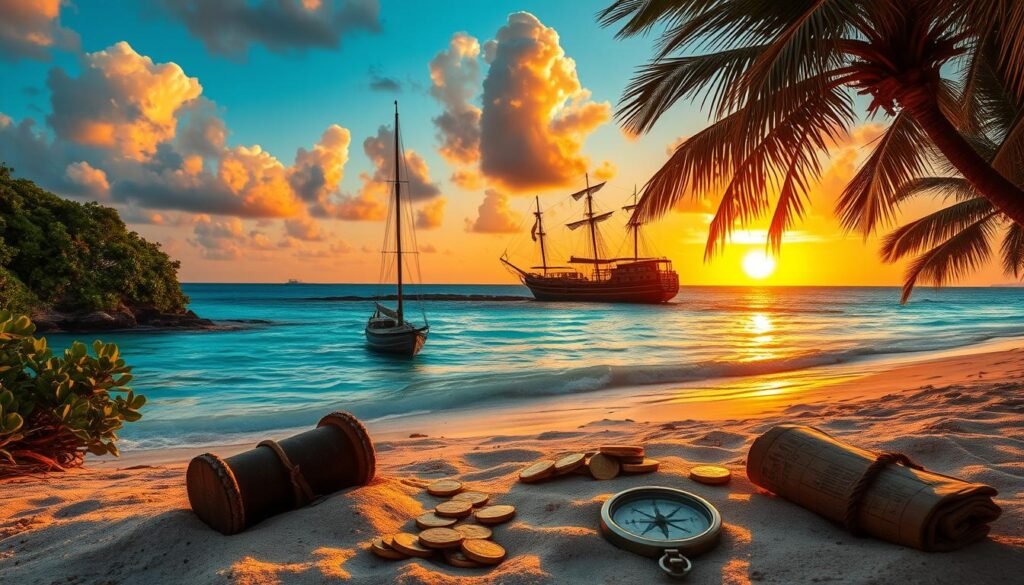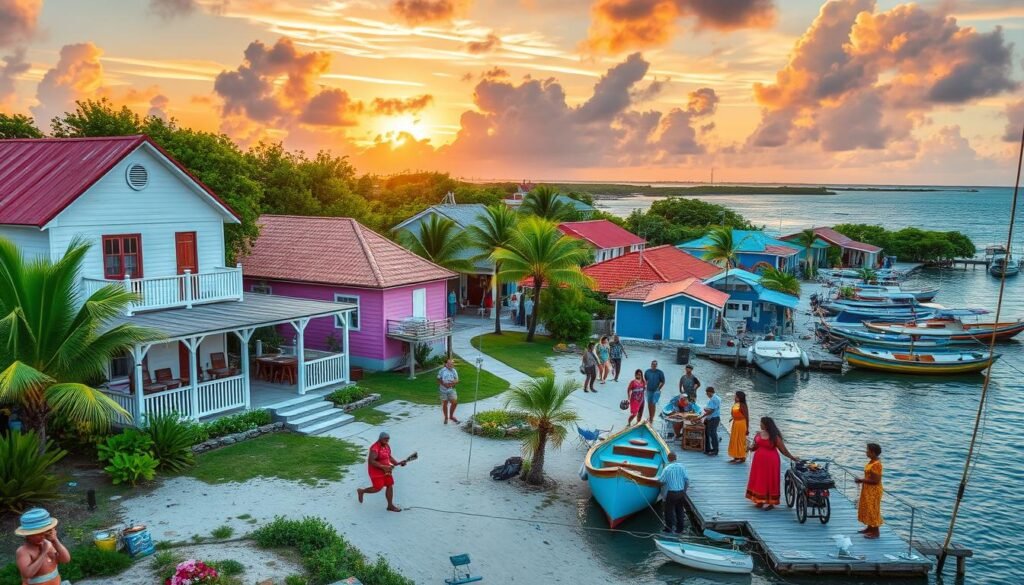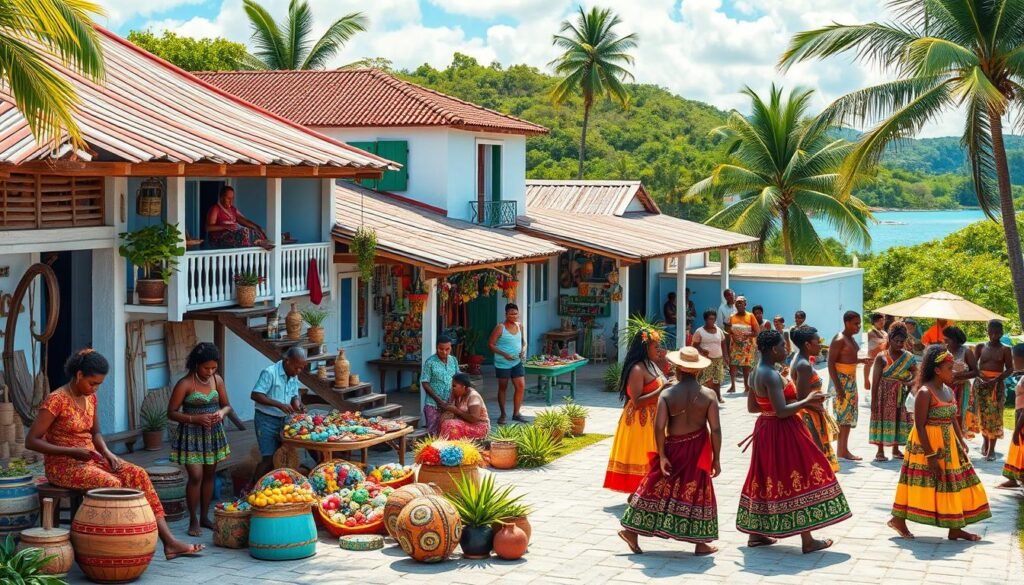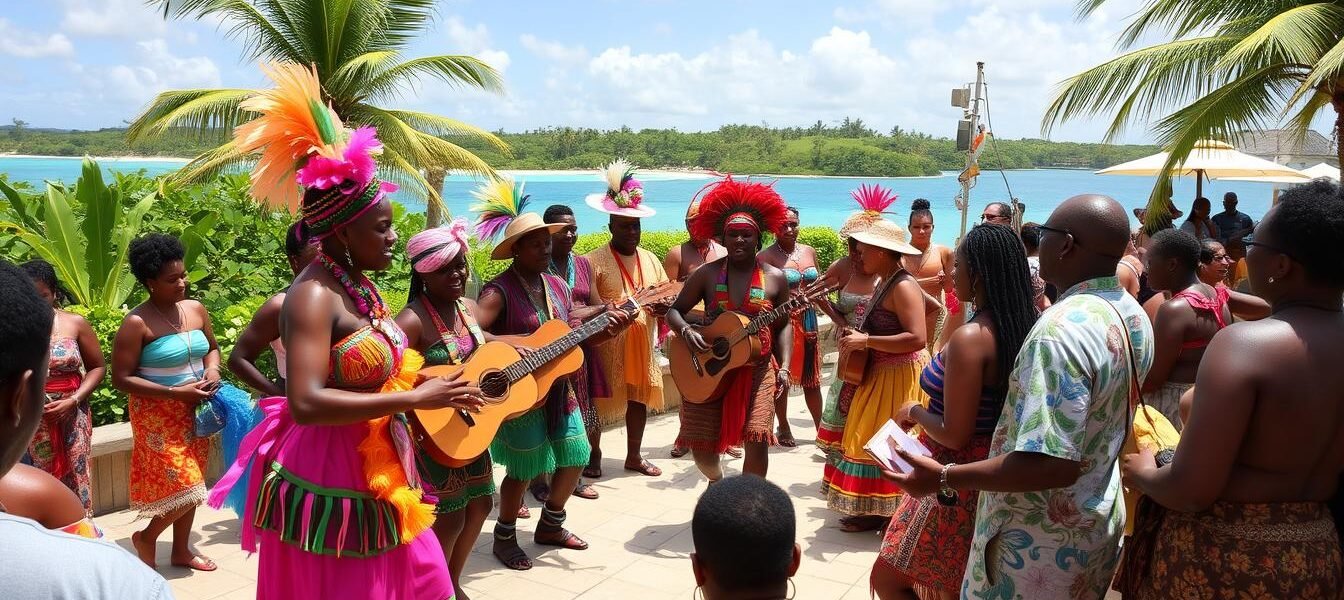Ever wondered what makes Abaco’s culture and heritage special in the Bahamas? The island’s history is a mix of Lucayan roots, pirate and British Loyalist influences. This blend shapes its unique identity. Abaco’s traditions, music, and food create a rich cultural scene that welcomes everyone.
Abaco’s history spans centuries, showing its growth as a cultural center in the Bahamas. Visitors are drawn to its history, from the peaceful Lucayans to European settlers and pirates. The island’s buildings, festivals, and food celebrate these moments, showing the spirit of its people.
In this article, we explore what makes Abaco’s culture and heritage unique. For more, check out this brief history of Abaco.
Key Takeaways
- Abaco’s culture is shaped by the influences of the Lucayan era and European colonization.
- The island has a vibrant tradition of music, food, and festivals celebrating its unique heritage.
- Architectural styles in Abaco reflect its diverse history and community spirit.
- Festivals offer visitors a glimpse into the cultural identity of Abaco’s inhabitants.
- Abaco’s lasting traditions continue to thrive through community efforts and local celebrations.
Introduction to Abaco’s Culture and Heritage
Abaco’s culture is a colorful mix of its long history and unique traditions. These traditions come from many different influences over time. The island’s heritage includes the stories of its first people, colonial settlers, and today’s community.
Archaeologists have found clues of the past, like pottery and military items1. Events like the Island Roots Heritage Festival draw big crowds, showing Abaco’s lively culture2. Festivals are key in keeping Abaco’s traditions alive, bringing people together to celebrate their shared history.
The Albert Lowe Museum, opened in 1976, shows Abaco’s dedication to its past2. It and other cultural efforts help keep the island’s heritage alive. By learning about Abaco’s culture, we understand its rich history and how it continues to grow.
The Lucayan Influence on Abaco’s History
The Lucayans first arrived in the Abaco Islands around 830 AD. They came from Hispaniola and Cuba. This marked the start of human life in Abaco’s history.
There were about 10,000 Lucayans. They lived well by farming, fishing, and hunting. Their arrival set the stage for the islands’ cultural growth, blending their Lucayan lifestyle with the local environment3.
The Arrival of the Lucayans
The Lucayans changed Abaco’s environment when they arrived. They used the islands’ natural resources wisely. In just a century, they spread across the Bahamas.
Their impact was huge, changing the islands’ culture and ecology3. They used slash-and-burn farming, changing Abaco’s pine forests. These changes are still seen today3.
Life and Production Techniques of the Lucayans
The Lucayans were skilled in using nature’s gifts. They made important items from local materials. This showed their creativity and ability to adapt.
Some of their cultural products include:
- Palmettoware and pottery made from natural fibers.
- Conch shell tools that showed their resourcefulness.
- Intricate basketry that showed their artistic talent.
The Lucayan way of life focused on community and caring for the environment. They farmed and fished, supporting their craft skills. This made them key to Abaco’s early economy.
Learn more about this fascinating time by visiting the Turks and Caicos National Museum. There, you can see artifacts like the Lucayan Duho, offering a glimpse into their rich culture4.

The Impact of Christopher Columbus on Abaco
Christopher Columbus landed on Bahamian shores in October 1492. This event changed Abaco and the Caribbean forever. He met the Lucayan people, who numbered around 40,000 at the time5.
Many Lucayans were taken to work in gold mines. This was the start of centuries of colonization.
European arrival brought big cultural changes to Abaco. The indigenous societies were dismantled. New farming and land use ideas came from European settlers.
This period also led to the exploitation of resources. It shaped the complex social dynamics of Abaco for centuries.
Columbus’s expeditions sparked European claims in the Bahamas. This led to conflicts and cultural exchanges. The slave trade began, bringing enslaved Africans to the Americas, especially Cuba.
Today, Abaco deals with the legacy of these events. It celebrates its rich history while facing colonial remnants.
For more on Abaco’s history and culture, check out Abaco’s historical significance.
“The impact of Christopher Columbus set the stage for centuries of transformation in Abaco.”
Understanding Abaco’s history is crucial. It helps grasp the island’s identity today. Knowing the past is key to Abaco’s future67.
Abaco’s Unique Pirate Legacy
The pirate era greatly shaped Abaco’s history, leaving behind legends that still influence the area today. The shallow waters around Abaco were a perfect hideout for pirates like Blackbeard and Charles Vane. They used the islands’ safe harbors to plan their sea adventures.
Their stories have enriched the island’s culture, making it a fascinating place to explore.
Famous Pirates of Abaco
Blackbeard is one of the most famous pirates of the pirate era. His clever tactics and fierce behavior made him a legend in Abaco and the Caribbean. Charles Vane also left his mark with his bold sea exploits.
These stories of piracy are a big part of Abaco’s history.
The End of Pirate Influence in Abaco
By the late 1720s, the pirate era was coming to an end. Governor Woodes Rogers was key in getting rid of pirates from Bahamian waters. This move ended a time of lawlessness.
After pirates left, Abaco became isolated for many years. It started looking for new settlers and stability. This change marked a big shift in the island’s path, leading to its cultural growth.

British Loyalists: The New Settlers of Abaco
After the American Revolutionary War, many British Loyalists moved to Abaco. In late summer 1783, about 130 Loyalists left New York. This was the start of a big move to the islands. By November, the last group from New York arrived at Carleton, and another group from East Florida settled at Marsh Harbour8.
These settlers included families and soldiers. They were excited to farm the fertile land.
The Arrival of Loyalists in the Late 1700s
The Loyalists wanted to start plantations. Names like Curry and Adams are still common in Abaco today. But, they soon found the soil was shallow and water was hard to find. This made farming tough.
As time went on, growing crops like cotton and coffee became hard. Many had to move to find better land for farming9.
Agricultural Challenges Faced by Loyalists
By the early 1800s, things got even tougher. The British Emancipation in 1834 took away slave labor. This made farming even harder for the Loyalists.
They faced challenges from the land and changing social and economic times. These problems greatly shaped Abaco’s early history and how people settled there10.
Integration of Old Inhabitants and Loyalists
The culture of Abaco is a mix of the Old Inhabitants and Loyalists. The Old Inhabitants brought skills and traditions that shaped the island. They worked with the Loyalists, helping the community grow.
Contributions of the Old Inhabitants
The Old Inhabitants greatly influenced Abaco. They knew a lot about the sea and fishing. Their skills helped start a strong fishing industry. They also taught traditional crafts, adding to the island’s art.
Blend of Cultures and Development of Abaco
The mix of cultures between the Old Inhabitants and Loyalists helped Abaco grow. This blend led to new social customs and stronger community ties. Together, they created a unique identity and drove progress in the area.

Statistical estimates suggest that approximately 15 percent of the Loyalists, totaling about 65,000-70,000 individuals, ultimately relocated to other British Empire territories after their defeat in the American Revolutionary War11. Moreover, between 15% and 20% of the 2 million white population in the colonies around 1775 identified as Loyalists, representing around 300,000 to 400,000 people11. The Loyalists who fled the U.S. were compensated with over £3 million for their losses, equivalent to about 37% of the total claims11.
| Aspect | Old Inhabitants | Loyalists |
|---|---|---|
| Fishing Techniques | Expertise in marine navigation | Adapting methods for trade |
| Cultural Practices | Traditional crafting and festivals | English customs and festivities |
| Agricultural Contributions | Local knowledge of crops | Introduction of new agricultural practices |
| Community Influence | Foundation of social networks | Expansion of settlements and trade |
Their teamwork helped Abaco grow. The Old Inhabitants’ traditions mixed with the Loyalists’. This mix helped the area’s social and ecological systems grow strong12.
Economic Ventures: From Wrecking to Agriculture
Abaco is famous for its history in the wrecking industry. It has moved through different economic areas. The wrecking industry started because of shipwrecks on the island’s reefs. Locals used their sea knowledge for salvage work.
Wrecking: A Lucrative Industry for Abaco
In the wrecking industry’s peak, Abaco became a key place for salvaging. It greatly helped the local economy. This work gave people skills and a strong seafaring culture.
The wrecking industry’s legacy helped start new economic areas in Abaco today.
Agrotechnology: Pineapples and Citrus Cultivation
Abaco’s economy changed with the start of agriculture. Its soil is perfect for growing pineapples and citrus. This change was a big step in Abaco’s history.
It led to more farming, not just for locals but also for export. This growth showed Abaco’s economy was getting stronger and more varied13.
Abaco’s Architectural Heritage
Abaco’s architecture shows a rich history of cultural strength and change. The island is filled with 19th-century buildings that mix Colonial and Bahamian styles. Wooden and stone homes show the island’s community spirit, built with local labor and materials.
Typical Structures from the 19th Century
Exploring Abaco’s 19th-century buildings, you see more than just homes. They reflect a lifestyle deeply connected to the island’s culture. The villages’ buildings are designed to handle the local weather, showing the value of local materials and skills.
Impact of Hurricanes on Architectural Heritage
Hurricanes have greatly affected Abaco’s buildings. The storms forced the community to rebuild and grow stronger. After each storm, new designs were made to protect against future damage.
This cycle of destruction and rebuilding has helped Abaco adapt. The island’s buildings now show modern designs that learn from past storms. This shows Abaco’s cultural strength as it keeps its heritage alive while facing nature’s tests.

The community also celebrates its boat-building traditions, like in Man-O-War Cay. For more on these traditions, see this article on Abaco’s boat-building history14.
Traditional Bahamian Music: Rake ‘n’ Scrape in Abaco
Abaco culture is rich in music, especially Rake ‘n’ Scrape. This music is full of energy and unique sounds. It brings people together at local events and celebrations.
Importance of Rake ‘n’ Scrape
Rake ‘n’ Scrape is more than music; it’s a symbol of unity and pride in Abaco. It’s a big part of festivals like the Annual Island Roots Heritage Festival. This shows the community’s cultural background and pride.
The beats of Rake ‘n’ Scrape share stories of the islands. They help people understand Abaco culture better. Music events like the Junkanoo Summer Festival keep this tradition alive for the future.
| Event | Description | Features |
|---|---|---|
| Island Roots Heritage Festival | A festival connecting the communities of Green Turtle Cay, Abaco, and Key West Florida. | Cultural activities, traditional music, and community engagement. |
| Sandy Point Homecoming Fest | Promotes Bahamian sailing sloops and regattas. | Sailing competitions, local music, and community festivities. |
| Junkanoo Summer Festival | Offers an immersive Bahamian cultural experience. | Dance, music, food, and traditional parades. |
This celebration makes people feel connected and teaches newcomers about Bahamian music. Rake ‘n’ Scrape’s sounds and rhythms show Abaco’s identity. It’s a key part of the community’s history1516.
Modern Abaco: Challenges and Resilience
In today’s Abaco, we see the effects of colonization and urbanization. These changes have altered social dynamics, threatening traditional ways of life. The community’s resilience is key in facing these challenges.
Effects of Colonization and Urbanization
Colonization’s legacy is still felt, with urbanization changing Abaco’s landscapes. Modernization pushes for economic growth, like the $177 million Treasure Cay project. This project aims to create jobs and support community growth17.
This effort shows the balance between economic needs and preserving Abaco’s culture.
Community Efforts to Preserve Culture
The people of Abaco are dedicated to saving their culture. They work on historical education and keeping traditions alive. For example, the Elbow Reef Lighthouse Society keeps the last kerosene lighthouse running18.
This shows the community’s commitment to their culture and the Bahamas’ heritage.

Festivals and Celebrations: A Reflection of Abaco’s Culture
Abaco’s culture shines through its festivals and celebrations. Events like the Cheeseburger in Paradise are more than food. They bring people together, showing the Abaco culture spirit. These gatherings mix food, music, and fun, connecting locals and visitors.
Cheeseburger in Paradise: A Culinary Celebration
Cheeseburger in Paradise is a key festival in Abaco. It celebrates local food and traditions. People enjoy tasty dishes and feel the warmth of Abaco’s traditions. It’s a highlight of the local festival scene.
The Role of Local Events in Cultural Heritage
Local events are vital for keeping cultural heritage alive in Abaco. They showcase traditional music, crafts, and food. Festivals help generations share stories and celebrate their heritage, keeping Abaco’s traditions alive.
| Festival Name | Type | Frequency | Highlights |
|---|---|---|---|
| Cheeseburger in Paradise | Culinary Celebration | Annual | Food, music, community engagement |
| Junkanoo | Cultural Festival | Bi-annual | Costumes, music, traditional dances |
| Abaco Music Festival | Music Celebration | Annual | Live performances, local artists |
Connectivity Through Local Cuisine
Abaco’s food scene is a mix of flavors and traditions from its diverse culture. Local dishes show off the island’s traditional ingredients. Visitors get to try unique dishes like conch salad and fried snapper in local spots.
Unique Dishes and Ingredients in Abaco’s Menu
Abaco’s restaurants offer a wide range of local dishes. You’ll find everything from stewed conch to boiled fish. Lobster and conch are big in the local diet.
Places like Kow’s Conch Stand and Thrisie’s Restaurant Bar & Grill are must-visits. They serve these seafood favorites. Miss Emily’s Blue Bee Bar is also famous for its Goombay Smash, a local drink that’s as lively as the food20.
Dining Experience in Abaco’s Restaurants
Dining in Abaco ranges from casual to upscale, offering a warm welcome. The colorful decor and friendly staff make every place inviting. Whether it’s Pete’s Pub & Gallery or Nipper’s Beach Bar & Grill, you’ll enjoy the views and flavors20.
Joining the People-to-People program can make your dining experience even better. You’ll get to eat with locals and try authentic Bahamian meals. It’s a great way to connect with the island’s culture21.

Environmental Factors Influencing Abaco’s Heritage
The unique environmental factors of Abaco shape its culture and heritage. The island’s beautiful landscape enriches the Abaco culture. It influences the lifestyle and traditions of its people.
Studies show more tourists want to see nature and historical sites22. Tourism affects the local heritage, offering services that improve quality and reduce environmental impact22.
Higher tourism costs might lead to more local tourism. This lets locals connect more with their surroundings22. Great Abaco Island aims to restore sustainable practices, balancing economy and environment23.
Plans are in place to protect the island’s beauty while allowing growth23. Local businesses and tourism must work together. This ensures growth that respects the island’s heritage23.
Protecting Abaco’s heritage means linking its ecological impact with community values. This creates a sustainable future for all generations.
The Role of Education in Preserving Cultural Heritage
Education is key to keeping cultural heritage alive in Abaco. It teaches future generations about their history and traditions. This helps them feel proud of their roots. The Bahamian community, with its rich diversity, benefits a lot from these educational efforts24.
Recently, schools have made a big push to learn more about Abaco’s cultural heritage. Working together, libraries and cultural groups help uncover hidden stories. This makes history fun and accessible for everyone24.
New technology has made it easier to share historical stories and collections. This helps students and the community understand their heritage better. As more people join Bahamian society, education plays a key role in welcoming and valuing their contributions24.
Restoring sites like the Elbow Reef Lighthouse shows the dedication to preserving Abaco’s heritage. Schools help keep not just buildings but also the stories behind them alive. This keeps the community strong and connected25.

Education helps the next generation connect with their cultural heritage. There’s a growing need for more research and stories to be shared. This ensures that Abaco’s cultural heritage stays vibrant and meaningful for the future24.
Future of Abaco’s Culture and Heritage
Abaco’s culture is at a turning point. Modern trends meet with ancient traditions. It’s crucial to keep the essence of Abaco alive as tourism grows.
Current Trends Impacting Local Culture
The Island Roots Heritage Festival is key in linking past and future. It celebrates island roots and brings people together. Young people learn about their history through it.
In 2012 and 2013, students from Forest Heights Academy won the Abaco Junior Junkanoo Competition. This shows the future of Junkanoo is bright26.
The Family Research Center helped people find their family history at the 2013 festival. They went back two generations in their family trees26. Three generations of Charles Gates’ family were there, showing deep family ties26.
Modernization also includes building sustainable facilities. On Walker’s Cay, 16 cottages and 30 ‘glamping’ units are being built. This shows innovation in tourism and community spirit27.
Local and government groups are working together. They aim to preserve heritage while meeting today’s needs27.
As Abaco evolves, blending modern and traditional is key. This will help keep its rich heritage alive.
Conclusion
Abaco’s culture is a mix of history and tradition, showing the island’s lively spirit. Exploring its roots, from the Lucayan people to the British Loyalists, reveals its unique charm. It’s vital to celebrate these traditions to keep them alive for future generations.
Learning from past struggles, like Hurricane Sandy, teaches us about resilience. This knowledge helps Abaco face new challenges with strength and adaptability.
Getting to know Abaco through its food, music, and festivals helps us see its importance. Discussions on current issues and conservation efforts show a path forward. This path respects history while embracing change, ensuring a community that values its past and looks to the future in the face of modern challenges.
With ongoing talks, education, and community events, Abaco’s culture is set to flourish. The island’s spirit and respect for its heritage promise a bright future. Abaco will remain a shining example of Bahamian identity and cultural strength282930.
FAQ
What makes Abaco’s culture unique?
How can I learn more about Abaco’s cuisine?
Are there any cultural festivals in Abaco?
How has the architecture of Abaco been influenced by its history?
What challenges does modern Abaco face?
Can I make reservations at Abaco’s restaurant?
What are some popular activities to do on Abaco’s island?
How can I buy Abaco’s products online?
What are some dining options available in Abaco?
Why is education important for preserving Abaco’s cultural heritage?
Source Links
- https://www.tribune242.com/news/2014/may/14/tough-call-cultural-heritage-heart-concerns-abaco-/
- https://abacosun.com/2016/01/21/green-turtle-cay-cultural-activities/
- https://www.ancient-origins.net/news-history-archaeology/bahamas-0015017
- https://www.floridamuseum.ufl.edu/wp-content/uploads/sites/44/2017/04/JCA_berman_intro_final.pdf
- https://www.thetravel.com/what-is-abaco-known-for/
- https://traveljamii.com/history_details/137
- https://archaeologymag.com/2024/02/discovery-of-largest-cluster-of-sunken-vessels-reveals-grim-legacy-of-slave-trade/
- https://www.marinalife.com/articles/cruising-through-history
- https://reason.com/1974/10/01/abaco/
- https://islandmapstore.com/2019/05/the-history-of-abaco-bahamas/
- https://en.wikipedia.org/wiki/Loyalist_(American_Revolution)
- https://www.mdpi.com/2071-1050/11/4/1080
- http://www.ediplomat.com/np/post_reports/pr_bs.htm
- https://www.nassauinstitute.org/article548/
- https://www.abacoescape.com/AbacoVideos/AbacoVideoEnter.html
- https://www.tourismtoday.com/sites/default/files/docs/calenderofevents.pdf
- https://www.tribune242.com/news/2024/sep/12/177m-hoa-signed-for-treasure-cay-development/
- https://www.bahamianproject.com/2022/02/guardians-of-the-light/
- https://www.sandals.com/blog/bahamas-carnival-junkanoo/
- https://www.forbes.com/sites/abigailabesamis/2022/07/29/where-to-eat-and-drink-in-the-abacos-bahamas/
- https://www.bahamas.com/plan-your-trip/people-to-people
- https://scholarworks.gvsu.edu/cgi/viewcontent.cgi?article=1073&context=jti
- https://digitalcommons.andrews.edu/arch-books/3/
- https://journals.sfu.ca/cob/index.php/files/article/view/280/pdf_47
- https://artsandculture.google.com/story/preserving-cultural-heritage-worldwide-cultural-heritage-center-us-department-of-state/jgXBNdIGicrpkQ?hl=en
- https://abacosun.com/2013/08/26/island-roots-festival-bridging-past-and-future/
- https://opm.gov.bs/prime-minister-davis-walkers-cay-hoa/
- https://www.notesfromtheroad.com/westindies/abaco-islands.html
- https://abacoprofessionals.com/2024/01/06/abaco-your-trusted-guide-to-financial-success/
- https://gerbersunderway.com/the-abacos-northern-bahamas-islands/





